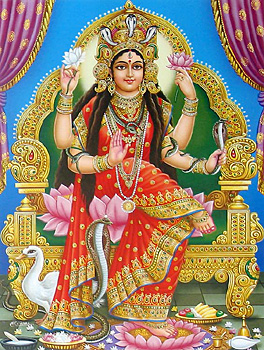 Food offerings to Goddess Manasa are an example of the survival of ancient traditions, namely, custom of appeasement. Elaborate rituals are performed in honour of Manasa, the Hindu snake Goddess, in the second month of the rainy season. In Bengal, as in many other parts of India, snakes tended to infest the waterlogged rice fields and densely vegetated areas. One bite from a poisonous species such as the Indian cobra and the Indian krait could cause instant death. As a result of this, the villagers used to throw themselves on the mercy of the snake Goddess, make offerings to her and pray for survival as they went about their necessary agricultural tasks. So great was the fear of snakes and so ingrained was the belief that feeding the creatures (as surrogates of the goddess) could ensure life and safety, that many rural households made a habit of leaving a bowl of milk out for the snake to consume on certain auspicious days of the year.
Food offerings to Goddess Manasa are an example of the survival of ancient traditions, namely, custom of appeasement. Elaborate rituals are performed in honour of Manasa, the Hindu snake Goddess, in the second month of the rainy season. In Bengal, as in many other parts of India, snakes tended to infest the waterlogged rice fields and densely vegetated areas. One bite from a poisonous species such as the Indian cobra and the Indian krait could cause instant death. As a result of this, the villagers used to throw themselves on the mercy of the snake Goddess, make offerings to her and pray for survival as they went about their necessary agricultural tasks. So great was the fear of snakes and so ingrained was the belief that feeding the creatures (as surrogates of the goddess) could ensure life and safety, that many rural households made a habit of leaving a bowl of milk out for the snake to consume on certain auspicious days of the year.
The biological fact that snakes only eat rodents and other live creatures that they hunt had no effect on the persistent belief in the efficacy of the milk. In a peculiar concurrence, when a particular snake happened to make its nest near a house and yet, over time, none of the family was bitten, the popular psyche transformed the object of terror almost into a household creature. It was referred to as a vastu shaap, or resident snake, and a nightly ration of milk was left out for it with as much punctiliousness as if it was a pet cat.
The enormous mangrove forests of the Sunderbans area of Bengal are the domain of the fearsome Bengal tigers that often hunt man as prey, unlike tigers in other parts of India. The locals, who depend on harvesting honey from the forest areas, have no option but to risk their lives as they venture ashore. Over time, however, they have endowed both the tiger and the forest itself with mythical dimensions embodied in the legend of Bon Bibi (forest goddess) and Dakkhin Rai (the tiger as god). In the story, an unscrupulous merchant propitiates the evil Dakkhin Rai by abandoning a young man called Dukhey who was a member of his ship`s crew. The tiger god would feast on Dukhey and, in return, let the merchant conduct his business without interference. Dukhey is rescued from the tiger`s grasp because of his heartfelt prayers to Bon Bibi and her brother who magically transport him to a safe location. The underlying belief, however, is that if a powerful predator like the tiger can be appeased with a satisfying meal (in this case, a designated human being), he may permit people to earn their livelihood.
Thus, the concept of appeasement of Gods and Goddesses in order not to incur their wrath is the reason behind offering food as appeasement to Goddess Manasa.









